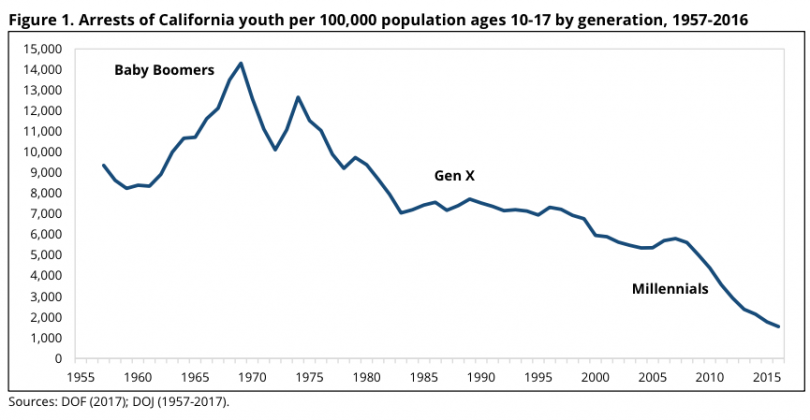Arrest rates for kids in California dropped for the ninth year in a row in 2016, according to a fact sheet from the Center on Juvenile and Criminal Justice (CJCJ)’s Mike Males.
In 2016, the number of arrests of juveniles between the ages of 10 and 17 dropped by 9,180, over the previous year, according to recently released US Department of Justice numbers.
While the arrest rate has been hitting new record lows every year since 2007, the numbers have been on a general downward trend for more than 40 years, Males says. Millenials (people born between 1982-2004) have the lowest juvenile arrest rates ever recorded in California. Approximately 5 percent of Millenials were arrested as juveniles, compared with 8 percent of Generation X members (born between 1961-1981), and 11 percent of Baby Boomers (born between 1943-1960). And the youngest generation, Generation Z (born in 2005 or later), is so far, showing considerably lower arrest rates for kids under the age of 12 than in the Millenial, Gen X, and Baby Boomer groups.
“Each generation of California Youth, from Generation X onward, has lowered the state’s rate of youth arrest…” Males writes. “Yet the state of California has budgeted for an increased population at its Division of Juvenile Justice and has sponsored a study proposing the construction of new prison facilities for young adult men. The state is proceeding as if younger-age crime levels remain high.”
Well, not completely.
Governor Jerry Brown did sign several important juvenile justice reform bills this past fall that became state law January 1, 2018, and intend to help the youth who do get arrested and convicted break free of the incarceration cycle.
One of the bills, SB 312, opens a path for people who committed crimes before their 17th birthday—and who have “demonstrated full rehabilitation” during a waiting period—to petition the courts to seal their juvenile records for certain offenses.
Another, SB 395, ensures kids under the age of 15 meet with a lawyer before a police interrogation and before waiving their Miranda Rights. Originally, the bill extended the protection for all juveniles, but was amended to only protect kids under the age of 15 in order to pass.
A third bill, SB 394, will allow people who received life-without-parole sentences as juveniles to be eligible for a parole hearing at the end of 25 years. This bill will bring California into compliance with the 2016 US Supreme Court ruling that the 2012 Miller v. Alabama decision, which, declared mandatory LWOP sentences for juveniles to be unconstitutional, must be applied retroactively.
The governor also approved SB 190, blocks local jurisdictions from imposing onerous fees and fines for juvenile justice system involvement.
And at the county level, where most kids in the state are incarcerated, the Los Angeles County Board of Supervisors voted in November to adopt a sweeping plan to divert thousands of the county’s youth away from the juvenile and criminal justice systems, connecting them instead to a comprehensive array of supportive services.
Advocates who praise the new LA County diversion plan believe that as a state, we are locking up too many kids for just being kids. “It’s time to end another stupid juvenile justice practice,” Human Rights Watch senior children’s rights advocate, Elizabeth Calvin, tweeted on January 1. “We need to stop incarcerating children for status offenses and nonviolent misdemeanors.”


Society is becoming more lax and permissive with respect to what it perceives as illegal, laws have been re-written and “watered down”, law enforcement is no longer taking a proactive approach in enforcing drug related offences.
A good sign, until society feels “things are out of control” again and a clamp down is called for. The circle of life for a civil society I guess.
By gone are the days of holding “kids” accountable and making being in custody a miserable thing. This “downward trend” explains why millenials, in general, are much more wussified than previous generations.
[…] Justice said arrests of young people dropped in 2016 for the ninth year consecutively, continuing a pattern of decline that has persisted for more than four decades as California turned into a minority-majority […]